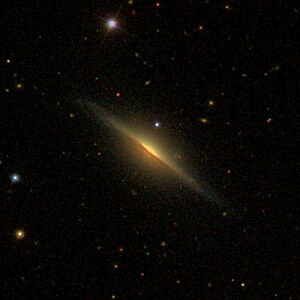NGC 825
| Galaxy NGC 825 |
|
|---|---|

|
|
| SDSS recording | |
| AladinLite | |
| Constellation | whale |
|
Position equinox : J2000.0 , epoch : J2000.0 |
|
| Right ascension | 02 h 08 m 32.3 s |
| declination | + 06 ° 19 ′ 25 ″ |
| Appearance | |
| Morphological type | Sat |
| Brightness (visual) | 13.3 mag |
| Brightness (B-band) | 14.2 mag |
| Angular expansion | 2 ′ × 0.5 ′ |
| Position angle | 53 ° |
| Surface brightness | 13.2 mag / arcmin² |
| Physical data | |
| Affiliation | LGG 47 |
| Redshift | 0.011333 ± 0.000017 |
| Radial velocity | 3398 ± 5 km / s |
|
Stroke distance v rad / H 0 |
(154 ± 11) · 10 6 ly (47.2 ± 3.3) Mpc |
| history | |
| discovery | Albert Marth |
| Discovery date | November 18, 1863 |
| Catalog names | |
| NGC 825 • UGC 1636 • PGC 8173 • CGCG 413-046 • MCG + 01-06-045 • 2MASX J02083236 + 0619255 • KCPG 56B • LDCE 0140 NED003 | |
NGC 825 is a spiral galaxy of Hubble type Sa in the constellation Cetus the southern sky , the 154 million estimated light years from the Milky Way 's center. The galaxy IC 208 is in optical proximity . The galaxy is the brightest member of the NGC 825 group ( LGG 47 ).
The object was by astronomer Albert Marth on November 18, 1863 using a 48-inch - telescope discovered.
Web links
NGC 825 group ( LGG 47 )
| Galaxy | Alternative name | Distance / million Lj |
|---|---|---|
| NGC 825 | PGC 8173 | 154 |
| IC 1776 | PGC 7952 | 155 |
| IC 208 | PGC 8167 | 160 |
| PGC 8214 | UGC 1649 | 150 |
| PGC 8207 | UGC 1646 | 153 |
